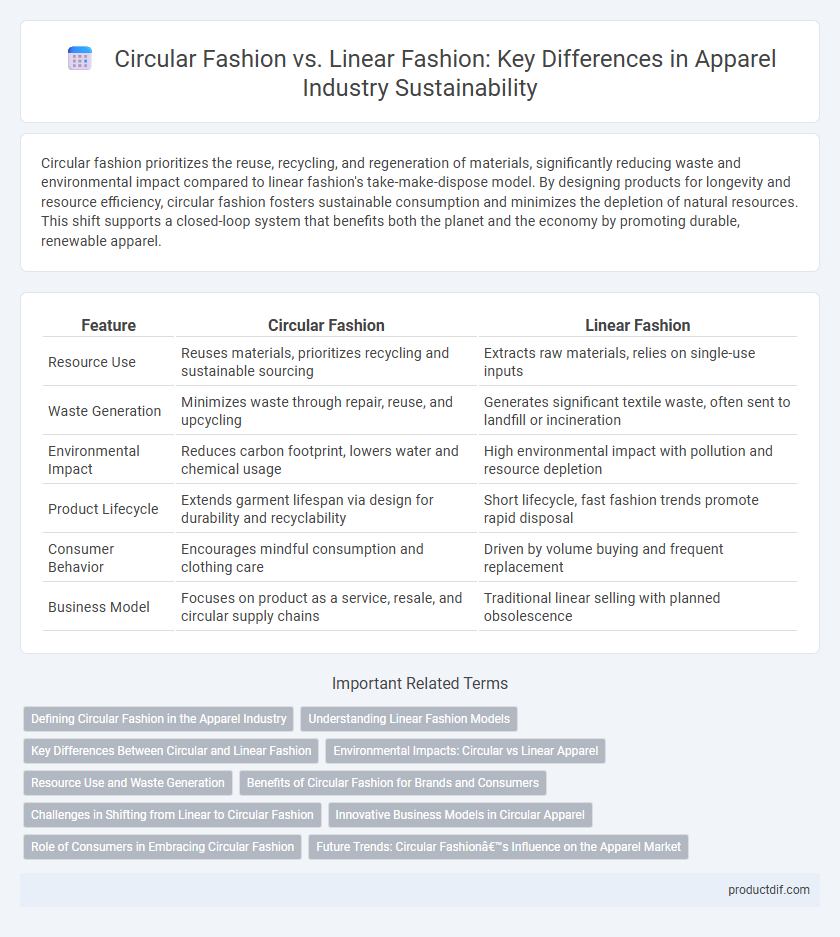Circular fashion prioritizes the reuse, recycling, and regeneration of materials, significantly reducing waste and environmental impact compared to linear fashion's take-make-dispose model. By designing products for longevity and resource efficiency, circular fashion fosters sustainable consumption and minimizes the depletion of natural resources. This shift supports a closed-loop system that benefits both the planet and the economy by promoting durable, renewable apparel.
Table of Comparison
| Feature | Circular Fashion | Linear Fashion |
|---|---|---|
| Resource Use | Reuses materials, prioritizes recycling and sustainable sourcing | Extracts raw materials, relies on single-use inputs |
| Waste Generation | Minimizes waste through repair, reuse, and upcycling | Generates significant textile waste, often sent to landfill or incineration |
| Environmental Impact | Reduces carbon footprint, lowers water and chemical usage | High environmental impact with pollution and resource depletion |
| Product Lifecycle | Extends garment lifespan via design for durability and recyclability | Short lifecycle, fast fashion trends promote rapid disposal |
| Consumer Behavior | Encourages mindful consumption and clothing care | Driven by volume buying and frequent replacement |
| Business Model | Focuses on product as a service, resale, and circular supply chains | Traditional linear selling with planned obsolescence |
Defining Circular Fashion in the Apparel Industry
Circular fashion in the apparel industry emphasizes designing, producing, and consuming clothing in ways that minimize waste and extend product lifecycles through reuse, recycling, and sustainable materials. This model contrasts with linear fashion's take-make-dispose approach by fostering closed-loop systems that reduce environmental impact and promote resource efficiency. Innovations such as biodegradable fabrics, garment repair programs, and resale platforms exemplify circular fashion's commitment to sustainability and long-term ecological balance.
Understanding Linear Fashion Models
Linear fashion models follow a traditional take-make-dispose approach, relying heavily on mass production and fast consumption of apparel items. This method contributes to significant textile waste and environmental degradation due to limited recycling and reuse practices. Understanding these models highlights the urgent need for transformation towards more sustainable circular fashion systems.
Key Differences Between Circular and Linear Fashion
Circular fashion emphasizes recycling, reuse, and sustainability by designing products to minimize waste and extend lifecycle, while linear fashion follows a take-make-dispose model that promotes single-use and quick turnover. Circular systems prioritize resource efficiency and reducing environmental impact through closed-loop production, whereas linear systems typically result in higher material consumption and landfill waste. Key differences include material sourcing, product design for durability, and end-of-life management, highlighting circular fashion's role in mitigating pollution and conserving resources.
Environmental Impacts: Circular vs Linear Apparel
Circular fashion significantly reduces environmental impacts by promoting garment reuse, recycling, and sustainable materials, thereby minimizing textile waste and lowering carbon emissions. Linear fashion relies heavily on resource extraction, leading to increased water pollution, landfill waste, and higher greenhouse gas emissions throughout production and disposal stages. Adopting circular apparel models enhances resource efficiency and supports a regenerative economy, crucial for mitigating the fashion industry's ecological footprint.
Resource Use and Waste Generation
Circular fashion minimizes resource use by prioritizing recycling, upcycling, and sustainable materials, significantly reducing waste generation compared to linear fashion's take-make-dispose model. Linear fashion relies heavily on virgin resources and produces substantial textile waste that often ends up in landfills or incinerators. Embracing circular fashion enhances resource efficiency, lowers environmental impact, and promotes a closed-loop system within the apparel industry.
Benefits of Circular Fashion for Brands and Consumers
Circular fashion enhances brand reputation by promoting sustainability and reducing environmental impact, leading to increased consumer loyalty and market differentiation. Consumers benefit from circular fashion through access to durable, high-quality apparel made from recycled materials, promoting eco-conscious purchasing habits and extended garment lifecycles. This model reduces textile waste and lowers carbon emissions, supporting global efforts toward a more sustainable and responsible fashion industry.
Challenges in Shifting from Linear to Circular Fashion
Shifting from linear to circular fashion involves overcoming significant challenges such as redesigning supply chains to incorporate sustainable materials and enabling garment recycling processes. Brands face high costs in developing durable, recyclable textiles and establishing take-back programs while maintaining profitability. Consumer acceptance and behavior change also pose obstacles, requiring education about circular principles and the value of second-hand or refurbished apparel.
Innovative Business Models in Circular Apparel
Innovative business models in circular apparel focus on extending product life cycles through resale, leasing, and take-back programs, reducing waste and resource consumption. Brands are increasingly adopting closed-loop systems that prioritize material recovery and recycling to create new garments from old textiles. These models enhance sustainability by shifting away from linear fashion's traditional 'take-make-dispose' approach, fostering a regenerative economy in the apparel industry.
Role of Consumers in Embracing Circular Fashion
Consumers play a crucial role in embracing circular fashion by prioritizing sustainable purchasing choices, such as selecting clothing made from recycled or renewable materials and supporting brands with transparent supply chains. Engaging in practices like clothing rental, resale, and proper garment care extends the lifecycle of apparel, reducing waste and environmental impact. Consumer demand drives industry innovation, encouraging designers and manufacturers to adopt circular models that minimize resource consumption and promote recycling and upcycling.
Future Trends: Circular Fashion’s Influence on the Apparel Market
Future trends in the apparel market indicate a significant shift toward circular fashion, driven by increasing consumer demand for sustainable and eco-friendly products. Circular fashion emphasizes resource efficiency through recycling, upcycling, and extended garment life cycles, contrasting with the waste-heavy linear model of take-make-dispose. Brands adopting circular practices report enhanced brand loyalty and reduced environmental impact, positioning circular fashion as a key driver in the industry's evolution.
Circular fashion vs Linear fashion Infographic

 productdif.com
productdif.com